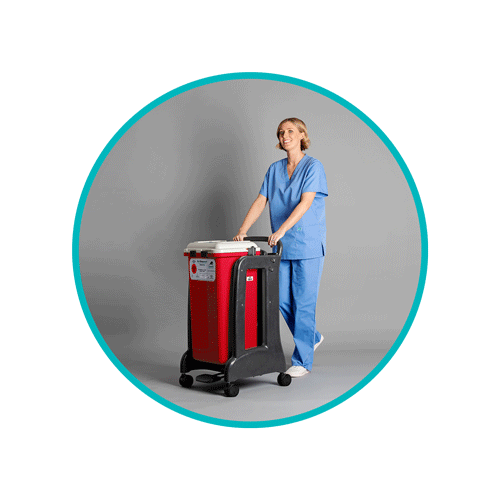Guide to North Dakota Medical Waste Regulations

North Dakota, whose nicknames include the Roughrider State and Heaven on Earth, is home to less than one million people. While the state may be sparsely inhabited compared to others, its heritage and history is among the richest in the country. Its major cities – Grand Forks, Fargo, and Bismarck – as well as outlying regions of the state are home to nearly fifty general acute care and critical access hospitals.
Hospitals, cancer centers, outpatient surgical centers, dental facilities, and veterinary services are scattered throughout the state, and each produces different types and volumes of medical waste. When it comes to North Dakota medical waste regulations, compliance is key. This is especially true when it comes to infectious and hazardous waste management processes.
TOPICS WE WILL COVER:
1 / Who oversees medical waste regulations in North Dakota?
2 / Infectious waste guidelines for healthcare facilities
3 / A 10-step approach to compliance in North Dakota
4 / Infectious waste guidelines for healthcare facilities
5 / Follow North Dakota’s medical waste regulations
Who oversees medical waste regulations in North Dakota?
North Dakota’s Department of Environmental Quality’s (NDDEQ’s) Division of Waste Management is responsible for the enforcement of not only state and federal environmental laws that regulate different types of medical waste, but how such materials are stored and how they are to be disposed of.
The NDDEQ provides information on programs that deal with solid waste, hazardous waste, and radiation controls for medical equipment and technologies such as x-ray machines, mammography, and other diagnostic testing capabilities. Know and follow the rules for waste management in the state. This is vital when dealing with potentially infectious or hazardous waste of any kind.
Infectious waste guidelines for healthcare facilities
Regardless of the size or type of healthcare facility, infectious waste must be handled carefully. Generators are required to segregate regulated infectious waste from other types of waste. Infectious waste is to be placed in red bags or otherwise distinctively colored containers that are labeled as infectious waste along with a universal biohazard symbol with the word “Biohazard” plainly noted on the container. Such containers must also be tear resistant and leak- and puncture-proof.
A number of publications are published and accessible on the NDDEQ website for assistance in managing regulated infectious waste, including:
- Infectious waste treatment/disposal facilities
- A guide to understanding North Dakota’s infectious waste regulations
There is no excuse for a healthcare waste generator not knowing the rules for medical waste management in the state. State guidelines are clear. Additionally, federal regulations must also be followed and can be found on the websites and materials of the Environmental Protection Agency (EPA), the Centers for Disease Control and Prevention (CDC), and the Occupational Safety and Health Administration’s (OSHA) blood-borne pathogens and needlestick prevention publications.
According to North Dakota’s infectious waste guide, infectious waste is defined as: solid waste that may contain pathogens with sufficient virulence and in sufficient quantity that exposure of a susceptible human or animal to the solid waste could cause the human or animal to contract an infectious disease. Regulated infectious waste includes but is not limited to:
- Sharps
- Cultures and stocks
- Human blood and blood products
- Pathological Waste
- Animal waste
- Isolation waste
- Unused sharps
North Dakota’s Administrative Code Title 33 provides specific guidelines for hazardous waste management. Topics covered in Title 33 include identification and listing of hazardous waste as well as standards for generators and transporters. Permits and permitting procedures are also covered. 
Chapter 33-24-03 (Standards for generators) is very specific regarding topics such as identification numbers and registration certificates, general requirements of manifests and their tracking numbers, usage of manifests, as well as topics covering packaging, labeling, and the amount of time such waste can be accumulated. For example, NDCC 33-24-03-03 (Identification number and registration certificate) specifies that generators are not allowed to treat, store, dispose of, transport, or offer for transportation any hazardous waste without having first received an identification number and a registration certificate from the DEQ, which may be obtained online.
North Dakota’s laws regarding medical waste management and their accompanying regulations are clear, easy to find, and very specific. Medical waste generators are urged to adhere to the “cradle to grave” approach to healthcare waste management. The medical waste generator is the ultimate responsible party when it comes to proper management and disposal of potentially hazardous or infectious waste processes – even after it leaves the facility.
The NDDEQ has recently added compliance assistance to their website to aid hazardous waste generators in maintaining compliance, and they also publish a hazardous waste compliance guide that can be accessed here.
A 10-step approach to compliance in North Dakota
North Dakota’s Department of Environmental Quality publishes guidelines for hazardous waste generators that offer a 10-step approach to management of hazardous waste. They include:
- Identification of waste streams as well as generator status
- Information on obtaining state/EPA site identification numbers
- Details regarding containers, labels, markings, and placards
- Specifics about storage regulations and how much and how long waste can be accumulated
- Transportation and disposal processes
Remember – a listed hazardous waste is identified as containing one or more of the following criteria: ignitability, corrosivity, toxicity, or reactivity. That means that such waste can be severely detrimental or even fatal to humans in low doses or can increase the risk of illness or contamination through toxic components if such waste is not managed properly.
About Sharps
Specific questions regarding sharps are also addressed in the state’s Century Codes, such as whether syringes without a needle attached must be managed as infectious waste. According to the code, if the syringe (even without a needle attached to it) has contained blood or blood products, bodily fluids, or an infectious agent, it “must be managed as an infectious waste. All other syringes (i.e. dose syringes, irrigation syringes) may be managed as a solid waste. The appropriate solid waste hauler, transfer station (if used) and disposal facility must be informed of your practices.”
Sharps are to be rendered “non-sharp” prior to disposal. State guidelines specify that sharps must be disinfected or incinerated and that sharps that have not been incinerated must be rendered non-sharp before disposal. The applicable and approved processes that render sharps a non-sharp can include shredding, grinding, and encapsulation, typically in materials such as grout, epoxy, and concrete.
Note: North Dakota’s Century Code is a set of state statutes that have been passed by the state’s legislature and signed into law by the governor. North Dakota’s Administrative Codes provide clarity as well. For example, Articles 33-24 of North Dakota’s Administrative Code deal with hazardous waste management.
The details are extremely important to ensure compliance and to reduce the risk of fines and penalties, not to mention endangering healthcare personnel, the general public, or the environment.
While the majority of medical waste generated at medical facilities are not classified as infectious waste, proper processes and care must always be observed to ensure that such waste does not end up in a regular solid waste strea
Follow North Dakota’s medical waste regulations 
Daniels Health urges any and all medical waste generators in the state of North Dakota to follow regulations of the NDDEQ as well as those of the federal government to maintain compliance. Doing so not only protects healthcare personnel from preventable sharps injuries, but potential damage to people or the environment through improper waste management processes. For information regarding our products, resources, and services that can help you to maintain compliance in the state of North Dakota, call one of our representatives today.
Let's Talk!
Your time is valuable, and we don’t want to play hard to get. You can either phone us directly on the details listed on our contact page, or feel free to fill out this short form and one of our team members will get back to you as quickly as possible.
